Friday Apr 19, 2024
Friday Apr 19, 2024
Thursday, 30 July 2020 00:10 - - {{hitsCtrl.values.hits}}
If the 19th Amendment is dismantled and the independent Election Commission scrapped and subjugated, 5 August 2020 will be the last free (if not entirely fair) election we shall have. That’s why a
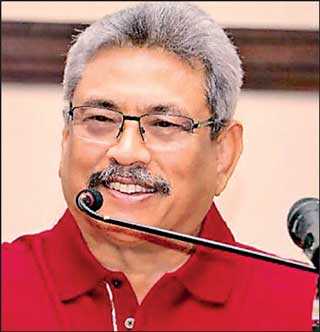 |
| President Gotabaya Rajapaksa |
 |
| Prime Minister Mahinda Rajapaksa |
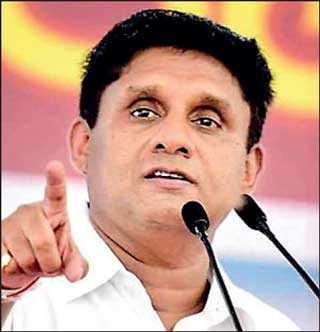 |
| SJB Leader Sajith Premadasa |
two-thirds majority has to be put out of the regime’s reach. But how?
We are told that the ruling party needs a two-thirds majority to combat extremism and terrorism, while safeguarding national sovereignty. Why are they lying to us?
The evidence shows that President Mahinda Rajapaksa crushed northern terrorism without a two-thirds majority and President Premadasa did the same earlier with southern terrorism, also without a two-thirds majority.
Mahinda Rajapaksa did in under three years (2006-’09) and Ranasinghe Premadasa did in under one year (Jan-Nov 1989), what President J.R. Jayewardene armed with a five-sixths majority, couldn’t do in north or south in 10 years (1978-1988 in the north) and three years (1986-1988 in the south) respectively.
As for national sovereignty, President Premadasa sent back a foreign military force of 70,000 and President Mahinda Rajapaksa faced-down Western pressure to declare a cessation of hostilities, permit evacuation and resume talks with the Tigers, without a two-thirds majority.
Two-thirds scam
What of “extremism”? The Tamils turned to separatism and terrorism precisely when the Sirimavo Bandaranaike Government wielded a two-thirds majority.
The JVP which had entered the peaceful democratic path contesting the District Development Council Elections while its leader Rohana Wijeweera contested the Presidential Election, returned to armed violence when the Jayewardene Government, wielding its five-sixths majority, prevented anyone from running for Parliament by postponing Parliamentary Elections for a whole term.
On the northern front, the fairly small LTTE grew exponentially after Black July 1983, which occurred on the watch of the Jayewardene administration with its five-sixths majority.
Terrorism, extremism and threats to sovereignty grew under governments with two-thirds majorities, while they were successfully defeated/rolled back by governments without a two-thirds majority. Put differently, the evidence shows that the exact opposite of what is claimed by the ruling party regarding a two-thirds majority, is true. So, we are being blatantly lied to about the desirability of a two-thirds majority, which going by the evidence is the very worst outcome possible at an election.
Why then are the rulers pushing so hard for a two-thirds majority? Having abandoned economic rationality they have to fall back on the falsehood that it is an insufficiency of centralised presidential 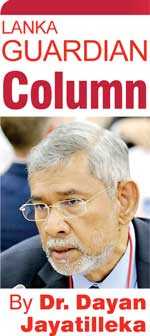 power that blocks delivery. 19A vests considerable power in the Prime Minister and given that he and the President belong not merely to the same party but the same family, the scenario of a dysfunctional deadlock as in Yahapalanaya is absurd.
power that blocks delivery. 19A vests considerable power in the Prime Minister and given that he and the President belong not merely to the same party but the same family, the scenario of a dysfunctional deadlock as in Yahapalanaya is absurd.
Real reasons
But there is another possible answer—a truer one—to the question “Why is a two-thirds majority really being sought?” During Watergate, a New York Times cartoon showed a grinning President Nixon saying: “Power corrupts, and absolute power is even better!”
A two-thirds majority is sought to constitutionalise an entirely new power-structure, discernible in skeletal outline in the combination of the Presidency and the largely monoethnic, mono-religious Presidential Task Forces monopolised by the security apparatus.
A new Constitution is needed to complete the project of a ‘Terminator Presidency’; a presidency which is genetically morphed with the military and the chosen clergy, and whose coding carries the ideology of those two strata.
That hyper-presidency will tilt the playing field, loading the electoral system to forestall any permutation and combination of the minorities and moderate, progressive Sinhala democrats from winning.
The President’s reminder during his monthly meeting with the Buddhist Advisory Council, of the Kuragala issue and his indignation at the ‘inactive’ Archaeological Department presence there, is 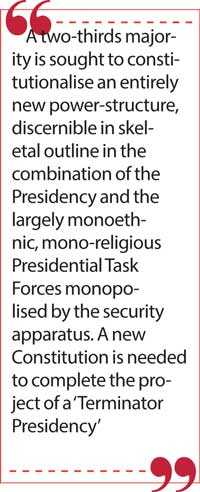 symptomatic. As instructive is his reflex action during election walkabouts, of contacting the Army Commander instead of the relevant officials when citizens request something as ‘civic’ as a playground.
symptomatic. As instructive is his reflex action during election walkabouts, of contacting the Army Commander instead of the relevant officials when citizens request something as ‘civic’ as a playground.
Ali Sabry PC was attacked on LankaCNews, a pro-Weerawansa site, for his (premature) praise for the deletion of ethnicity/religion from the new birth certificate. Social media warriors urge that Arun Tambimuttu be denied a preference vote.
The Mahinda comeback movement avoided anti-minority ideology in 2015-2017, acutely conscious that it had been damaged in January 2015 by Sinhala extremist lobbies. From Nugegoda 2015 to Galle Face Green 2017 and the local election 2018, racism/religio-chauvinism was not preponderant in the mix.
However, in early 2018 the outrageous “fertility pills” fake news and agitation in Ampara had its echoes in the SLPP. On the one hand the SLPP began to embrace Islamophobic and anti-devolution currents (active at least since 2012), and on the other, those currents infiltrated the SLPP/JO through the GR project, having captured that project.
At the August 2020 election, racism/religio-chauvinism is a strong factor, just as it was November 2019. Even the PM just declared that “separatism which could not win by the bullet will not be permitted to achieve the same goal by ballot”, while failing to cite any evidence of such a threat. Post-election, ethno-religious supremacism will weaponise the presidency and seek legislative and constitutional expression and entrenchment. That’s also what the two-thirds majority is for.
Catholic votes are currently courted, but during its previous stint in power, the Sinhala-Buddhist Far-Right jailed a Catholic nun belonging to the Order founded by Mother Theresa, made nuns kneel at gunpoint and shot into churches (Weliweriya). Unarmed Catholics were killed in several such incidents (Katunayake FTZ, Chilaw, Weliweriya). 
A two-thirds majority for the ethno-religious supremacist agenda will render Sri Lanka toxic and inflammable. The massive unemployment and economic depression that will inevitably result from the de-coupled, closed economy model (“deysheeya arthikaya”) the President openly espouses, will generate social disaffection that will be diverted against the “alien” minorities as in Germany during the Great Depression. Neofascism could arise.
Lose-lose scenario
It is in the best interests of all, including the Rajapaksas and the SLPP, not to be cursed by a two-thirds majority. They can avoid the fate of the SLFP after the latter’s only experience with a two-thirds (1970-’77). At the 1977 election, the Tamil party got more seats than the SLFP, depriving it of the leadership of the Opposition (Mr. Amirthalingam was Opp. Leader until his withdrawal from parliament over the 6th Amendment). The SLFP was out of office for 17 years and its leader lost her civic rights. She never led the country again.
With its five-sixths majority, the UNP was in danger in the late 1980s of being violently annihilated. President Premadasa saved it from brutal extinction and bought it a few years but he too was assassinated and the UNP never elected another President for the next 30 years, since Premadasa took office in January 1989.
If the SLPP is spared a two-thirds majority, President Gotabaya Rajapaksa is far less likely to be goaded by his ultranationalist constituency, high on its own supply, into driving into a wall or over a cliff, entailing the risk of a Milosevic/former Yugoslav outcome.
Mahinda Rajapaksa will, if granted only a simple majority rather than the burden of two-thirds, retain his power under the 19th Amendment instead of surrendering it to a politically-inexperienced President.
With only a simple majority, the SLPP’s coalition partners will evade the fate of that of the SLFP’s partners the last time that party obtained a two-thirds. They were driven from Parliament by the voters (1977).
A two-thirds majority for the Government will mean the Tamil and Muslim parties and the Left, the JVP and the FSP, will be subject to marginalisation, victimisation and suppression. This will not be because of any subversive activity, but because it is perceived as a necessary pre-emptive strike by the regime, to remove obstacles to the implementation of the new agenda of economic austerity/slashing public expenditure, dismantling/diluting devolution, and demographic re-engineering. 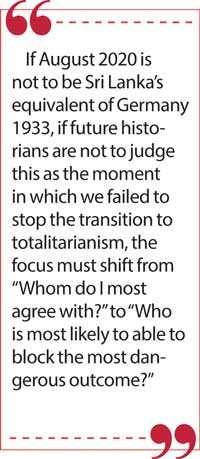
Tactical voting
If August 2020 is not to be Sri Lanka’s equivalent of Germany 1933, if future historians are not to judge this as the moment in which we failed to stop the transition to totalitarianism, the focus must shift from “Whom do I most agree with?” to “Who is most likely to able to block the most dangerous outcome?”
To break that down: “Who in the Opposition is most likely to secure the most votes and thereby be the most effective in blocking a two-thirds majority?” “Who is least likely to secure votes at this election and is therefore least likely to be an obstacle to a two-thirds majority?”
Wickremesinghe generates no enthusiasm even among his urbanised middle-class, smallish, mostly indoor/garden audiences. Twenty-six years as leader and never elected President, he states on the record that the time is not yet right for a leadership change and stipulates his condition that when that change does come it must be a “united” decision i.e. not by competitive secret ballot. Fossilisation dooms the UNP to be a political relic.
The JVP has lost its mojo. Its modest audiences watch as if they are in a tuition class or university lecture room, paying attention to their lecturers—which is apt because the JVP and its front, the NPP, is an almost entirely ex-campus/para-campus constituency organised as a political formation.
That leaves the SJB led by Sajith Premadasa, who is the only personality in the Oppositional space with the ‘chemistry’, the pulling power and ability to manifestly enthuse audiences. The SJB audiences, though understandably smaller than those of the ruling coalition, are comparable with those of the SLPP (as the UNP and JVP audiences are not).
Moreover, they are more multiethnic, multi-religious, multi-cultural and gender-balanced—an accurate, if modestly-sized mirror of the composite citizenry. The manifestly enthusiastic participation of Muslim women, alongside their Sinhala and Tamil sisters at Sajith’s rallies is the best response to Wahhabi-Salafist fundamentalism.
The SJB is easily looking like the biggest anti/non-SLPP political force that will emerge from this  election.
election.
If the goal is to avert a two-thirds tyranny, then, from a pragmatic ‘tactical voting’ perspective rather than those of habit, congruency or comfort, the best bet would be Sajith’s SJB.
Big picture
Those who sincerely uphold the vision of a liberal society must identify and avoid that which causes a massive backlash which impacts on the character of the successor administration, infusing it with Sinhala-Buddhist extremism. This happened to the UNP administrations in 1956 and 1970, was barely averted in 1988, and recurred in 2005 and 2019. The sole exception was the administration of President Premadasa, which was succeeded after a brief transition by a Blairite (neo)liberal SLFP administration of Chandrika Kumaratunga.
CBK’s quasi-federalist constitutional ‘package’ and Norwegian engagement generated—for the first time in SLFP history—a Sinhala backlash which durably shifted the leadership of the anti-UNP forces to the robustly nationalist Rajapaksas.
When the UNP neoliberals and SLFP liberals combined in Yahapalanaya, the Sinhala backlash took the steelier Alt-Right form of Gotabaya Rajapaksa. The only way the Yahapalana experiment could have worked was if it were a Karu Jayasuriya-Maithripala Sirisena hybrid. Given their previous experience with a Ranil premiership (2001-3) CBK and Mangala knew what he was like and would do, but did not insist on Karu instead.
The enduring legacy of Ranil-CBK-Mangala neoliberalism and its resultant recoil, Gotabayan ultra-nationalism, is the ‘new normal’. Every future administration will have to legitimise itself by declaring itself Sinhala-Buddhist, with the only choice being which brand of Sinhala-Buddhism it is: the harsh hegemonism of Gotabaya or the pluralist moderation of Sajith (invoking his late father).
The only time the UNP could not be outflanked on the Sinhala-Buddhist nationalist front was during the incumbency of Ranasinghe Premadasa, notwithstanding the fact that his discourse and policy practice were pronouncedly multiethnic, multireligious, multilingual and multicultural.
Notably, Sajith is the only mainstream leader to pledge the proscription of hate-speech.
Prime Minister Dudley Senanayake (1965-1970) appointed a Sinhala nationalist literary personality, IMRA Iriyagolla as the Minister of Education, while changing the universal calendar of Saturday/Sunday weekend holidays into the Buddhist “Poya and pre-Poya”. The UNP lost the election by a landslide. A Centre-Left coalition won a two-thirds.
Liberalism and pluralism are secured not by gestures of religio-cultural conservatism but by generating a sense of security in the Sinhala majority that the government is genuinely patriotic. Liberal-democracy can and will survive only as liberal-nationalism/nationalist-liberalism.
Moreover, core liberal-democratic values can be safeguarded only when encased in a policy regime of equity and strong social welfare. The actual or potential social bases of racism and xenophobia shrink through populist social security and upliftment programs.
These (Premadasa-ist) lessons were ignored by the UNP for the past quarter-century and it repeatedly paid the electoral price for such arrogant errancy. Sharing a panel in Colombo in 2015, Nobel prize-winner in Economics, Joe Stiglitz urged Prime Minister Wickremesinghe to make greater equity the Archimedean point and lever of post-conflict economic recovery and growth, cautioning against a neoliberal model. That advice, on the public record (reproduced on Stiglitz’ Harvard webpage), was totally ignored.
Siege vs. surge
The regime can be deterred or contained only by a countervailing political force that plays the role of the alternative government, capable of posing the credible threat of winning the next Presidential and parliamentary elections (2024/5). The present UNP, JVP and SLFP do not seem potential parties of governance.
The defining issue of our contemporary history was that of the long anti-secessionist war, and it is imprinted in the collective psyche that Wickremesinghe’s UNP appeased and collaborated with the enemy. This perception has been compounded by the shocking downgrading of national security, dismantling of military intelligence and resultant co-negligence in the face of Islamist-jihadist terrorism.
It is a memory the Rajapaksa regime finds easy to evoke. The country will never feel safe enough with a ‘Ranilist’ UNP, to return it to office. The only way to flatten the curve of the ultra-nationalist pandemic is to exorcise that ‘fear and loathing’. If voters—especially UNP voters—subtract/delete the longstanding factor of ‘Ranilism’ and pivot from that past, ultra-nationalism will lose traction because Sajith is simply not that kind of hate symbol for Sinhala-Buddhists. He changes the target profile, and is a moving target anyway. The Sinhala-Buddhist majority can then put the war and existential threats behind it, and focus rationally on socioeconomic and governance grievances.
Sajith’s SJB not only has war-winning Army Commander Sarath Fonseka and Sinhala-Buddhist nationalist Champika Ranawaka, but also several candidates who are retired senior officers, veterans of the wartime military, some from elite combat units.
The generational shift that Sajith personifies can offset ultranationalist radicalisation against an ossified democratic political system.
Traversing the country from far north to deep south, addressing almost 500 meetings, Premadasa is giving the Pohottuwa machine a run for its money, taking the fight—guerrilla warfare—to the Power, including a surge into its southern citadels of Beliatta, Mulkirigala, Walasmulla, Angunakolapalassa, Suriyawewa and Tissamaharama.
The best—the only—chance of stopping a two-thirds tyranny, salvaging the core values of liberal-democracy and pluralism, is a tactical vote for Sajith’s SJB. It is the strongest line of defence against despotism. The 300 at Thermopylae.